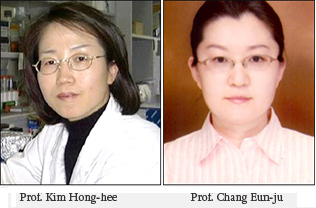 Professors at College of Dentistry identified the mechanism of a protein that controls and destroys cells, possibly leading to osteoporosis.
Professors at College of Dentistry identified the mechanism of a protein that controls and destroys cells, possibly leading to osteoporosis.
The researchers, headed by Professor Hong-Hee Kim and Eun-Ju Chang reported that the protein CK-B regulates the activation of osteoclasts, large multinuclear cells associated with the absorption and removal of bone. CK-B and other enzymes facilitate the formation of the destructive cells, which means that restricting the protein can reduce the risk of bone damage, according to the researchers, whose paper appeared in the Web edition of Nature Medicine.
In a series of experiments, mice showed a reduced loss of bone tissue when researchers mutated their genes so that they produced less CK-B. Those mice injected with a restrainer of the protein showed less bone damage, according to the article.
Bone density remains balanced in human bodies when the formation of osteoblasts and destruction by osteoclasts are equal. An imbalance, however, leads to bone problems, including osteoporosis, according to the researchers.
Approximately 2 million people in South Korea have osteoporosis, and cases of osteoporosis in 2003 grew more than 10-fold since 1995, according to data from the National Health Insurance Corp.
Kim said the recent study is the first to shed light on the link between osteoclast formation and the CK-B protein.
The result is meaningful in that it suggests a possible new target in developing bone-related cures by revealing the controlling mechanism of bones` activation and destruction, Kim said.
August 25, 2008
PR Office
SNU NOW
News
News
Professors at College of Dentistry Pinpoint Protein Mechanism that May Lead To Osteoporosis
Aug 26, 2008

